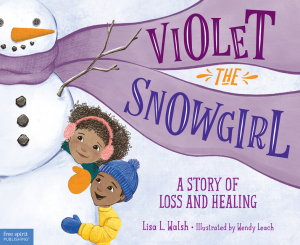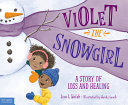 Reviewed by: Pat Corekin
Reviewed by: Pat Corekin
Review source: Teaching for Change
Book author: Lisa L. Walsh
Two children, Jerzie and Josiah, spend a day building a snowgirl with their grandmother. As they construct their snowgirl, their imaginations create a number of adventure stories — Violet the Snowgirl is a pilot, an alien, a third grade teacher, a librarian, a veterinarian, and even their grandfather, who had recently passed away. After their grandmother catches the train home and the warm weather melts their snowgirl, Jerzie and Josiah are left with a deep sense of sadness. Their mother, understanding this is much more than the loss of their snowgirl, doesn’t tell them to stop crying. In fact, she thinks “their sadness is just right.”
The children process their feelings by drawing pictures of their snowgirl and thinking about the memories of their time spent with their grandmother. Jerzie comes to realize: “Even though Violet was gone, she would always be part of Jerzie. Like Grandad. Her birthday. And the day she, Josiah, and Grandma built Violet. Nothing could ever take away those memories.”
This is a great book to introduce early elementary children to the grieving process and let them know it’s okay to feel sad.
Pat Corekin is a Social Justice Books publications specialist at Teaching for Change.


Violet the Snowgirl by Lisa L. Walsh
Published by Free Spirit Publishing on 2020
Genres: Death and Dying, Emotions & Feelings, Social Themes, Young Adult
Pages: 36
Reading Level: Grade K, Grades 1-2
ISBN: 9781631985171
Review Source: Teaching for Change
A versatile story that gives children permission to grieve and helps them find ways to cope with loss.
When third grader Jerzie wakes up the day after her birthday, she feels grumpy. Her birthday cheer is gone and she knows today is going to be nothing but boring--until she hears a knock at her door. Grandma's here! Grandma, Jerzie, and her little brother, Josiah, spend all day outside building and playing with Violet, a snowgirl that becomes a pilot, a teacher, a vet, and even their late granddad throughout the day.
But when a warm day comes and Violet melts, Jerzie and Josiah feel angry, frustrated, and sad. It feels like they've lost a loved one and they wonder why they even made her in the first place. Mom didn't tell Josiah to stop crying, or tell Jerzie to cheer up. Their sadness just seemed right.
Later that night, Jerzie still feels sad, but when she remembers the magical day Violet came to be, she can't help but smile a little. She helps Josiah remember how much fun they had with Grandma too, and she realizes that even though Violet is gone, just like her birthday, the memories will always be with her.
The stages of grief are complex, but using the simple analogy of building a snowman, Violet the Snowgirl is accessible and versatile. It helps children process change, like moving to a new school, and offers strategies for dealing with more difficult loss, like divorce or death. At the back of the book, mental health professionals, educators, and parents will find discussion questions, diagrams to help children understand and track their emotions, and resources for when additional support might be needed.
Leave a Reply